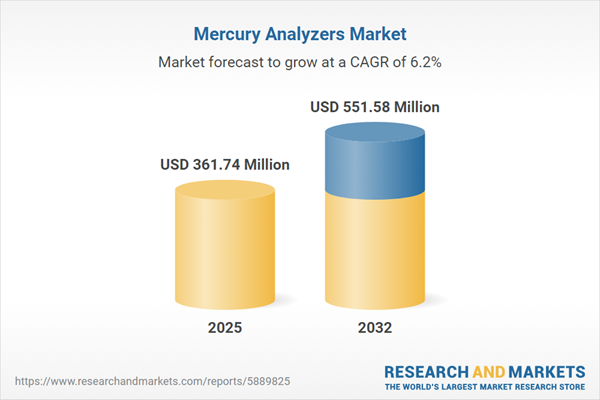Speak directly to the analyst to clarify any post sales queries you may have.
The mercury analyzers market is evolving rapidly as industries and regulators demand greater precision, compliance, and efficiency from mercury detection technologies. Organizations across sectors increasingly view investment in advanced mercury analysis as vital to risk management and environmental responsibility.
Market Snapshot: Mercury Analyzers Market Trends and Growth
The Mercury Analyzers Market grew from USD 340.75 million in 2024 to USD 361.74 million in 2025. It is projected to maintain a CAGR of 6.20%, reaching USD 551.58 million by 2032. This steady market performance reflects rising demand for accurate, repeatable mercury quantification solutions in environmental, industrial, and healthcare settings as global regulations tighten and stakeholder accountability rises.
Scope & Segmentation of the Mercury Analyzers Market
Senior decision-makers will find comprehensive analysis on the full range of mercury analyzer solutions, applications, and geographic variations, helping to prioritize technology investments and market strategy.
- Technology: Cold Vapor Atomic Absorption (benchtop, portable); Cold Vapor Atomic Fluorescence; Inductively Coupled Plasma Mass Spectrometry (axial view, radial view); Inductively Coupled Plasma Optical Emission Spectroscopy (sequential, simultaneous)
- Product Type: Benchtop; Portable
- Application: Drinking Water; Food; Soil (agricultural soil, contaminated soil); Wastewater
- End User: Academic and Research Institutes (research centers, universities); Environmental Testing Laboratories (government labs, private labs); Pharmaceutical Companies (generic pharma, large pharma)
- Distribution Channel: Direct Sales; Distributors (national distributors, regional distributors); Online Retail
- Geographic Coverage: Americas (United States, Canada, Mexico, Brazil, Argentina, Chile, Colombia, Peru); Europe, Middle East & Africa (United Kingdom, Germany, France, Russia, Italy, Spain, Netherlands, Sweden, Poland, Switzerland, United Arab Emirates, Saudi Arabia, Qatar, Turkey, Israel, South Africa, Nigeria, Egypt, Kenya); Asia-Pacific (China, India, Japan, Australia, South Korea, Indonesia, Thailand, Malaysia, Singapore, Taiwan)
- Competitor Analysis: Coverage includes companies such as Thermo Fisher Scientific, Agilent Technologies, PerkinElmer, Shimadzu, LECO Corporation, Teledyne Technologies, Elementar Analysensysteme, Buck Scientific, Analytik Jena AG, and Metrohm AG
Key Takeaways: Strategic Insights for Senior Decision-Makers
- Robust analytical capacity is now critical as environmental and regulatory demands merge, driving need for both on-site portability and high-throughput laboratory automation.
- Technology adoption is influenced by the need for operational efficiency, data integration, and flexibility to support both routine monitoring and specialized research.
- Manufacturers are designing platforms that combine modularity, calibration sophistication, and digital connectivity to reduce cost of ownership and streamline compliance reporting.
- Regional differences in regulation and infrastructure investment significantly shape solution requirements and growth rates across continents and industry sectors.
- The market is shaped by innovation in spectroscopy and emission technologies, with strategic partnerships accelerating product development and geographical reach.
- Organizations are increasingly embedding advanced analytics, cloud-based reporting, and preventive maintenance to sustain long-term performance advantages.
Tariff Impact: Navigating Regulatory Cost Pressures
The 2025 United States tariff adjustments on analytical instrumentation, particularly targeting essential mercury analyzer components, have prompted producers to revisit sourcing and operational strategies. Manufacturers are shifting toward diversified suppliers and near-shoring, while end users are prioritizing flexible procurement and inventory planning to ensure uninterrupted access and budget stability. These adaptations highlight how strategic procurement and supply chain agility are fundamental in a complex regulatory landscape.
Methodology & Data Sources
This report is based on an integrated multi-stage approach: extensive secondary research of scientific publications, regulatory directives, and industry benchmarks formed the foundation, complemented by direct interviews with laboratory leaders, environmental consultants, and equipment providers. Quantitative shipment and tariff datasets were validated through triangulation and expert panel review to ensure accuracy and relevance for decision-makers.
Why This Report Matters
- Enables C-level executives to benchmark growth strategies and procurement decisions against detailed regional and technological insights.
- Supports risk mitigation by outlining procurement best practices, tariff adaptation tactics, and compliance alignment across diverse regulatory frameworks.
- Guides technology selection with comparative analysis of instrumentation performance, end-user requirements, and emerging application scenarios.
Conclusion
The mercury analyzers market is shaped by relentless innovation, regulatory evolution, and operational complexity. Senior leaders will gain actionable clarity to inform technology investments, compliance planning, and supply chain resilience strategies.
Additional Product Information:
- Purchase of this report includes 1 year online access with quarterly updates.
- This report can be updated on request. Please contact our Customer Experience team using the Ask a Question widget on our website.
Table of Contents
3. Executive Summary
4. Market Overview
7. Cumulative Impact of Artificial Intelligence 2025
Companies Mentioned
The companies profiled in this Mercury Analyzers market report include:- Thermo Fisher Scientific Inc.
- Agilent Technologies, Inc.
- PerkinElmer, Inc.
- Shimadzu Corporation
- LECO Corporation
- Teledyne Technologies, Inc.
- Elementar Analysensysteme GmbH
- Buck Scientific, Inc.
- Analytik Jena AG
- Metrohm AG
Table Information
| Report Attribute | Details |
|---|---|
| No. of Pages | 194 |
| Published | October 2025 |
| Forecast Period | 2025 - 2032 |
| Estimated Market Value ( USD | $ 361.74 Million |
| Forecasted Market Value ( USD | $ 551.58 Million |
| Compound Annual Growth Rate | 6.2% |
| Regions Covered | Global |
| No. of Companies Mentioned | 11 |









